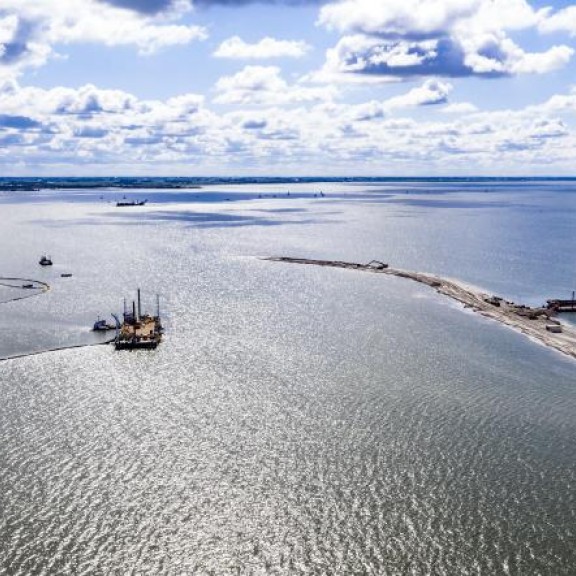
Building a wind farm: power for everyone
The Amsterdam/IJmuiden region and Port of Amsterdam are fully committed to (offshore) wind power. To facilitate the construction of wind farms, we are manufacturing and shipping various parts via the North Sea Canal Area.
In a series of four interviews, we share everything about our views on building wind farms on the water. The first to speak: Joris Hol, project leader at Wind Farm Fryslân.
It will supply roughly 500,000 households with power: Wind Farm Fryslân. While energy expert Ventolines and Bouwconsortium Zuiderzeewind are working hard on the construction, the port of Amsterdam supports the logistics processes.
Blades, towers, hubs: via the capital city’s port, all turbine parts make their way to the construction location at Breezanddijk in the IJsselmeer. And of course, so do the other components, such as Davit cranes and power cables. The Amsterdam region thus plays an important role in all this.
The world’s largest wind farm to be built in an inland waterway
Joris Hol knows, better than anybody, just how much is involved in building a wind farm. As a project leader at Ventolines, he has worked on similar projects many times. This time, he’s taking it one step further: coordinating the largest wind farm to be built in an inland waterway. He has been working on it for more than three years.
‘A very challenging period’, he says. ‘It is not just the construction project that is sizable, but so are all the other extra tasks involved. For example, the works on the ground, like laying kilometres of power cables along the Afsluitdijk. Or building the transformer station along the A7 at Breezanddijk.’
Local, as much as possible
Ventolines decided early on in the process to work with local suppliers and partners as much as possible. ‘This was also one of the demands from the shareholders’, explains Joris. ‘The province of Fryslân, for example, wanted this. They preferred a socially responsible approach, in which the expenses would trickle back to the residents of Friesland, as much as possible. For instance, in the way of employment opportunities.
We therefore had a Frisian company manufacture the internal platforms with cabling, for example. It required considerable time and energy. Bouwconsortium Zuiderzeewind rose to the challenge admirably. For instance, by conducting extra audits and safety inspections. At the same time, it was worthwhile to give the local companies an opportunity too. Not just the well-known parties that we always call on.’
Construction with respect for the surrounding environment
Corporate Social Responsibility (CSR) is essential when it comes to this project. ‘It involves more than just local employment opportunities’, says Joris. ‘We want to be good neighbours to the people, animals and the surrounding environment. That is why we are building an island nature reserve so the bird populations in and around the IJsselmeer will have a foraging area.
Integration into the landscape was also high on our agenda. So, we did not opt for a square concrete box as the transformer house at Breezanddijk, but instead, a beautiful building with a unique architectural design, fitted with moving and reflective facade panels. The building seemingly moves with the water and wind around it.’
The transformer station will soon also be accessible to the public. There, visitors can obtain information about the station and wind farm’s operations.
‘This leaves everyone better off’
Amsterdam, relatively close to West Friesland...
While it is mostly Frisian companies who will help to build the wind farm, TMA Logistics, situated in the port of Amsterdam, turned out to be an excellent logistics partner.
Joris: ‘The Alaskahaven in Amsterdam is large and deep enough to receive and tranship the turbine components that come from countries like China, Portugal, Morocco, Vietnam and Denmark. Sometimes, they require partial disassembly or deconstruction. The port of Amsterdam/IJmuiden is a linchpin in our project, and, thanks to its accessibility to the IJsselmeer, a logical choice for Zuiderzeewind.’
According to Joris, it is not just the port that offers many possibilities. ‘The people do too. They are flexible and practical and see that offshore wind power is the future. That is precisely the energy that we need to get the turbines in Wind Farm Fryslân moving in 2021. Also, to facilitate the construction of large wind farms in the future, on the North Sea, for example.’
Operational in the summer of 2021
A great deal must still happen until then. ‘We are already making excellent progress with the installation of the power supply on the land. We are also working hard building the transformer station that will convert the energy from the wind turbines to electricity. For now, we are right on schedule.’
The ‘wet work’, as Joris calls it, will start in September. Like getting the foundation piles into the water. And then, at the beginning of next year, construction of the actual turbines will start.
‘We want to complete construction around the summer of next year. Then, roughly 500,000 households will have access to Frisian renewable electricity. Households that jointly reduce carbon dioxide emissions by more than 800,000 tonnes per year.’